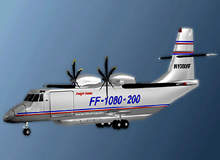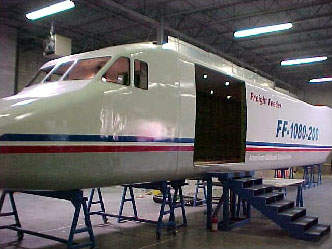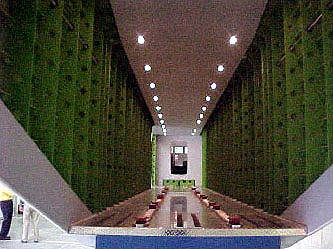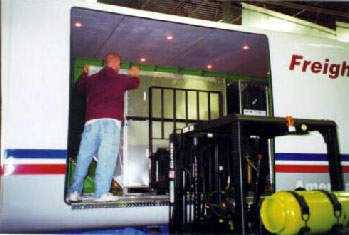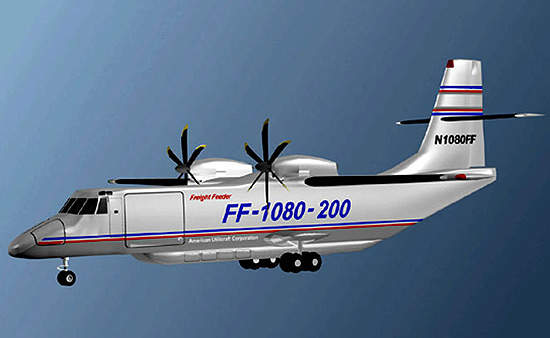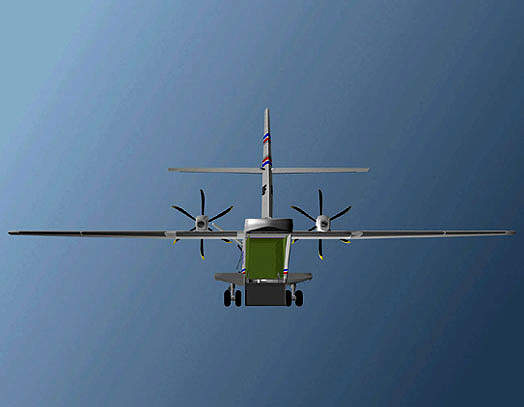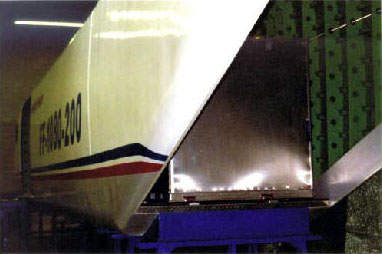Freight Feeder Aircraft Corporation (FFAC) is developing a new air freight feeder aircraft, the FF-5000, embodying an improved method of transporting containerised cargo. FFAC purchased the development programme from Utilicraft Aerospace Industries (formerly American Utilicraft Corporation, AMUC), located in Lawrenceville, Georgia, in December 2007. Utilicraft Aerospace Industries retains a 25% stake in the aircraft programme. The aircraft, previously called the FF-1080, was renamed in January 2008 following a redesign which will allow it to carry larger M-1 containers.
The FF-5000 has the capability to carry standard industry air containers on short to medium-range / medium-density routes and features an integrated air cargo information system for the freight feed market. The market niche for which the FF-5000 is targeted, is the immediate and future demands of e-commerce distribution for more shipments, in small quantities, delivered directly to consumer’s doors.
FF-5000 construction
In 1991, the company filed patents for the FF-1080 aircraft design and the ETA automatic freight tracking system. The company later filed an additional patent on an automated flat-rate system (AFRS) that improves fuel efficiency on each flight segment. In January 2000, AMUC began detailed engineering of the FF-1080-200 prototype aircraft with Aircraft Design Services Incorporated (ADSI) of San Antonio, Texas.
Metalcraft Technologies of Cedar City, Utah will manufacture the forward, centre and aft fuselage and empennage assemblies. M7 Aerospace will supply the prototype wing and power plant installation. In July 2007, Metalcraft cut first metal for the fuselage of the first FF-1080-200 prototype. Following the decision to change the design of the first prototype to the FF-5000, Metalcraft recommenced the construction in February 2008. The prototype is planned for completion by end of 2010.
Metalcraft Technologies Inc of Cedar City, Utah will be the manufacturer of the forward, centre, and aft fuselage and empennage assemblies. M7 Aerospace will supply the prototype wing and power plant installation. Final assembly of the FF-5000 aircraft will take place at Utilicraft’s final assembly facility on Double Eagle Airport, Albuquerque, New Mexico.
In January 2007, Utilicraft Aerospace Industries signed a letter of intent with R&D Development Corporation for the construction of a 55,500ft² flight test hangar and office facility, at Double Eagle II Airport, Albuquerque, for assembly of the aircraft.
In May 2009, Freight Feeder announced a “Green” FF5000 turbo-prop freighter aircraft. The aircraft will have the company’s patented AFRS that is claimed to reduce fuel consumption by 50%.
Orders and deliveries
Development of the FF-1080 was slowed down following the events of 9/11 but, in January 2004, AMUC announced that WSI Hong Kong would purchase the first production lot of 36 FF-1080 aircraft. In March 2004, the companies announced an exclusive distributorship agreement for the Far East markets, including the acquisition of 300 FF-1080 freight feeder aircraft.
In June 2004 AMUC and Global Air Group, of Brisbane Australia, signed a letter of intent for the purchase of 50 FF-1080 aircraft, with 50 on option. The purchase agreement was signed in November 2004.
In January 2007, Mid America Aero signed a letter of intent to buy ten FF-1080-300ER aircraft. In August 2007, this was extended to include ten of FF-1080-200 aircraft. In September 2007, Africa West signed a letter of intent for three aircraft plus two options.
In July 2008, Freight Feeder Aircraft Corporation signed a letter of intent with MK Airlines for the purchase of ten FF-5000 aircraft, with five on option.
Freight Feeder Aircraft signed a letter of intent with Singapore-based Boulder Group in June 2008 to supply five FF5000 aircraft with an option of another five.
In November 2009, a letter of intent was signed with Worldwide Perishables of Canada for supplying two FF5000s, with an option of three more. The aircraft has 50 orders under LOI with international customers.
The FAA part 25 certification process is scheduled to be completed in late 2010. The certification will allow the company to produce the FF4000 and FF5000 aircraft. Deliveries to customers will begin by the end of 2013.
Variants
The FF5000 military variant aircraft (FF5000MV) has features such as troop transport, medevac, mobile hospital, maritime surveillance, in-flight refuelling, equipment and cargo transport capabilities.
Design
The FF-5000 aircraft is an all-aluminium, twin-engine, high-wing, single pilot, turboprop aircraft specifically designed as a utility air freight transport system.
The aircraft is also designed for short take-off and landing (STOL), having the capability to take-off from airfields with less than 3,000ft of runway, expanding air cargo capacity to many smaller cities and airports. Only the cockpit is pressurised. The landing gear, from Castle Precision Technologies, is fixed.
Other systems are provided by: Auxilec Inc – electrical systems integration; HS Dynamic Controls – anti-icing and de-icing systems; Shaw Aero Devices – fuel management systems; and Securaplane Technologies – fire detection systems.
Cockpit
Cockpit Integrator for the FF-5000 “glass” cockpit will be Meggitt Avionics, based in Manchester, New Hampshire.
The aircraft will be fitted with the Meggitt MAGIC (Meggitt Avionics new-generation integrated cockpit) integrated flight and engine display system, which includes active matrix liquid crystal displays (AMLCD). Meggitt Avionics has also been selected to provide fuel quantity gauging system and the engine fire detection system.
UPS Aviation Technologies will supply GPS and navigation avionics.
Cargo
The production FF-5000 will be able to carry a containerised payload of over 15,875kg (35,000lb), in six AMA or AMJ containers or a combination of containers and pallets.
The aircraft has side and aft container doors. The cargo roller floor will be provided by AAR Cargo Systems. Hi-Temp Insulation is responsible for cargo bay insulation systems.
Engines
The aircraft is powered by two Rolls-Royce Allison AE2100D3 turboprop engines, which are rated at 33,415kW (4,580shp) each. The engines are fitted with FADEC (full authority digital engine control). Dowty provide the R391 six-bladed propellers.
ETA freight management system
Utility Aerospace Industries has developed and patented the ETA (express turn around) freight management system.
ETA is a real time computerised system which automatically provides information on barcode container ID, container weight, aircraft weight and balance and automatically transmits this freight data to the management HQ.
Automatic flat-rate system (AFRS)
Utility Aerospace Industries has developed and patented a new aircraft power management system, the automatic flat-rate system (AFRS).
The AFRS is designed to economically manage the power of turbine-powered aircraft engines and automatically sense and adjust the required engine power for take-off and cross country flight depending on aircraft weight and atmospheric and runway conditions. The AFRS is designed to provide a more fuel-efficient aircraft and also prolongs engine life, thereby increasing safety and reducing engine overhaul cost.
The AFRS computer receives input from the air data computer, the ETA (including gross take-off weight for each route segment) and the navigation and GPS computers (including airport location, runway length, atmospheric conditions and route profile) and then sends instructions to the engine to reset the power limits and the fuel flow curve.

